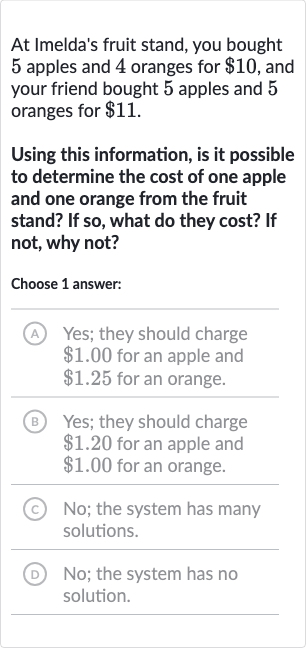AI tutor
Welcome to Bytelearn!
Let’s check out your problem:

At Imelda's fruit stand, you bought apples and oranges for , and your friend bought apples and oranges for . Using this information, is it possible to determine the cost of one apple and one orange from the fruit stand? If so, what do they cost? If not, why not?Choose answer:(A) Yes; they should charge for an apple and for an orange.(B) Yes; they should charge for an apple and for an orange.(C) No; the system has many solutions.(D) No; the system has no solution.
Full solution
Q. At Imelda's fruit stand, you bought apples and oranges for , and your friend bought apples and oranges for . Using this information, is it possible to determine the cost of one apple and one orange from the fruit stand? If so, what do they cost? If not, why not?Choose answer:(A) Yes; they should charge for an apple and for an orange.(B) Yes; they should charge for an apple and for an orange.(C) No; the system has many solutions.(D) No; the system has no solution.
- Equations Setup: Let's denote the cost of one apple as and the cost of one orange as . We can set up two equations based on the information given:For your purchase: For your friend's purchase:
- Elimination Method: We can subtract the first equation from the second to eliminate the apples and solve for the cost of one orange:This simplifies to
- Substitution: Now that we know the cost of one orange is , we can substitute this value back into the first equation to find the cost of one apple:
- Final Cost Calculation: We have found the cost of one apple to be \$\(1\).\(20\) and the cost of one orange to be \$\(1\).\(00\). This matches one of the answer choices provided.
More problems from Add and subtract integers: word problems
QuestionGet tutor help
QuestionGet tutor help
QuestionGet tutor help
QuestionGet tutor help
QuestionGet tutor help
QuestionGet tutor help
QuestionGet tutor help
QuestionGet tutor help
QuestionGet tutor help
